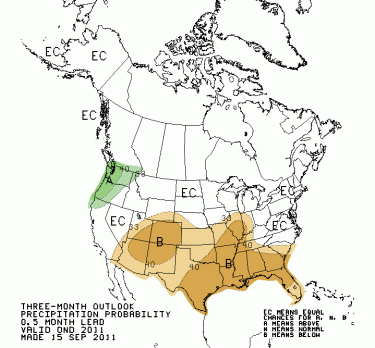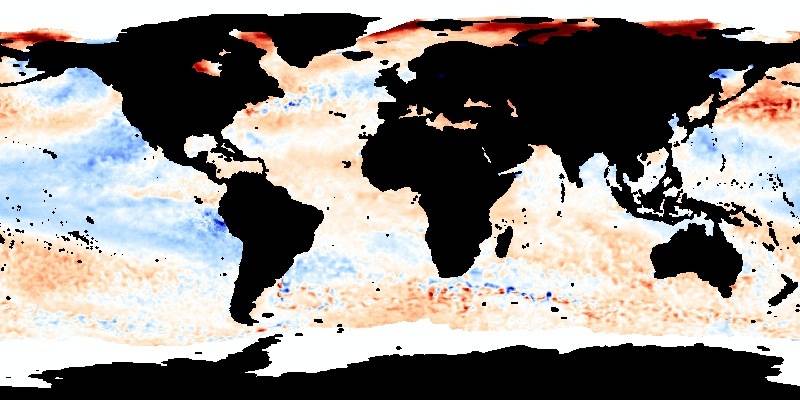
Does this mean Texas is toast?
As most Californians know, El Niño is a periodic unusual warming of the surface water in the eastern and central tropical Pacific Ocean. Actually, that’s pretty much a lie. Most people don’t know the definition of El Niño or its mirror image, La Niña, and truthfully, most people don’t much care.
What you do care about if you’re a Texan suffering through the worst one-year drought on record, or a New Yorker who had to dig out from massive snowstorms last winter (tied in part to La Niña), or a Californian who has ever had to deal with the torrential rains that trigger catastrophic mudslides (linked to El Niño), is that these natural climate cycles can elevate the odds of natural disasters where you live.
At the moment, we’re now entering the second year of the La Niña part of the cycle. La Niña is one key reason why the Southwest was so dry last winter and through the spring and summer, and since La Niña is projected to continue through the coming winter, Texas and nearby states aren’t likely to get much relief.
But Niñas and Niños (the broader cycle, for you weather/climate geeks, is known as the “El Niño-Southern Oscillation,” or “ENSO”) don’t just operate in isolation. They’re part of the broader climate system, which means that climate change could theoretically change how they operate — make them develop more frequently, for example, or less frequently, or be more or less pronounced. Climate change could also intensify the effects of El Niño and La Niña events.
Climate scientists have been wrestling with the first question for a while now, and they still don’t really have a definitive answer. Some climate models have suggested that global warming has already begun to cause subtle changes in ENSO cycles, and that the changes will become more pronounced later this century. But a new study, published in the Journal of Climate, doesn’t find much evidence for that.
But on the second question, the new study is a lot more definitive. “Due to a warmer and moister atmosphere,” said co-author Baylor Fox-Kemper, of the University of Colorado in a press release, “the impacts of El Niño are changing even though El Niño itself doesn’t change.”
That’s because global warming has begun to change the playing field on which El Niño and La Niña operate, just as it’s changing the background conditions that give rise to our everyday weather. The Texas drought is a prime example. It’s most likely cause is reduced rainfall from La Niña-related weather patterns. But however dry Texas and Oklahoma might have been otherwise, the killer heat wave that plagued the region this past summer — the sort of heat wave global warming is already making more commonplace — baked much of the remaining moisture out of both the soil and vegetation. No wonder large parts of the Lone Star State have gone up in smoke.

When the next El Niño occurs in a year or two, it will probably bring heavy rains to places like Southern California, whose unstable hillsides tend to slide when soggy. Except now, thanks to global warming, the typical El Niño-related storms that roll in off the Pacific may well be turbocharged, since a warmer atmosphere can hold more water. This is the reason, say many climate scientists, that downpours have become heavier in recent decades across broad geographical areas.
La Niña, plus the added moisture in the air from global warming, have also been partially implicated in the massive snowstorms that struck the Northeast and Mid-Atlantic states during the last two winters. Those could get worse as well, suggests the new analysis. “What we see,” says Fox-Kemper, “is that certain atmospheric patterns, such as the blocking high pressure south of Alaska typical of La Niña winters, strengthen…so, the cooling of North America expected in a La Niña winter would be stronger in future climates.” So to pre-answer the question that will inevitably be asked next winter: no, more snow does NOT contradict the idea that the planet is warming. Quite the contrary.
Finally, for those who really do want to know what El Niño and La Niña actually are, as opposed to what they do, you can go to NOAA’s El Niño page. But be warned: there will be a quiz, and the word “thermocline” will appear.
A version of this post also appears at Climate Central, a content partner of Climate Watch.
5 thoughts on “Global Warming May Worsen Effects of El Niño, La Niña Events”
Comments are closed.

What is the “first question” and what is the “second question” noted in the 5th graf? The only question posed is whether Texas is toast. Something edited out?
The first question is whether climate change will affect the ENSO cycles themselves–their frequency, for example. The second is whether it will intensify their effects irrespective of whether the cycles change. Nothing edited out, but perhaps I might have put it more clearly. Thanks for reading in any case!
Is that what that is coming from very high flying military aircraft
we thought was normal jet air contrails?
Still noone is addressing how weather modification programs of spraying aluminum and barium from high flying planes leaving long grid lines of aerosols is affecting “normal” climate patterns… scientists, weather reporters, public, environmental organizations, etc. are turning blind eyes toward the heavens—see geoengineeringwatch.org and californiaskywatch.com and You Tube/chem trails for what has been happening for about 10 years! And, noone investigating spraying or consequences.
Interesting article. It does make sense as global warming is superimposed on natural cycles, it can lead to enhanced effects.
In the Northeastern U.S., the La Nino cycle is fairly weak during the winter season as the North Atlantic Oscilation (NAO) is the stronger cycle (positive phase results in colder air from Canada and typically snowy periods). It will be interesting to see what effects global warming has on this atmospheric phenomenon.